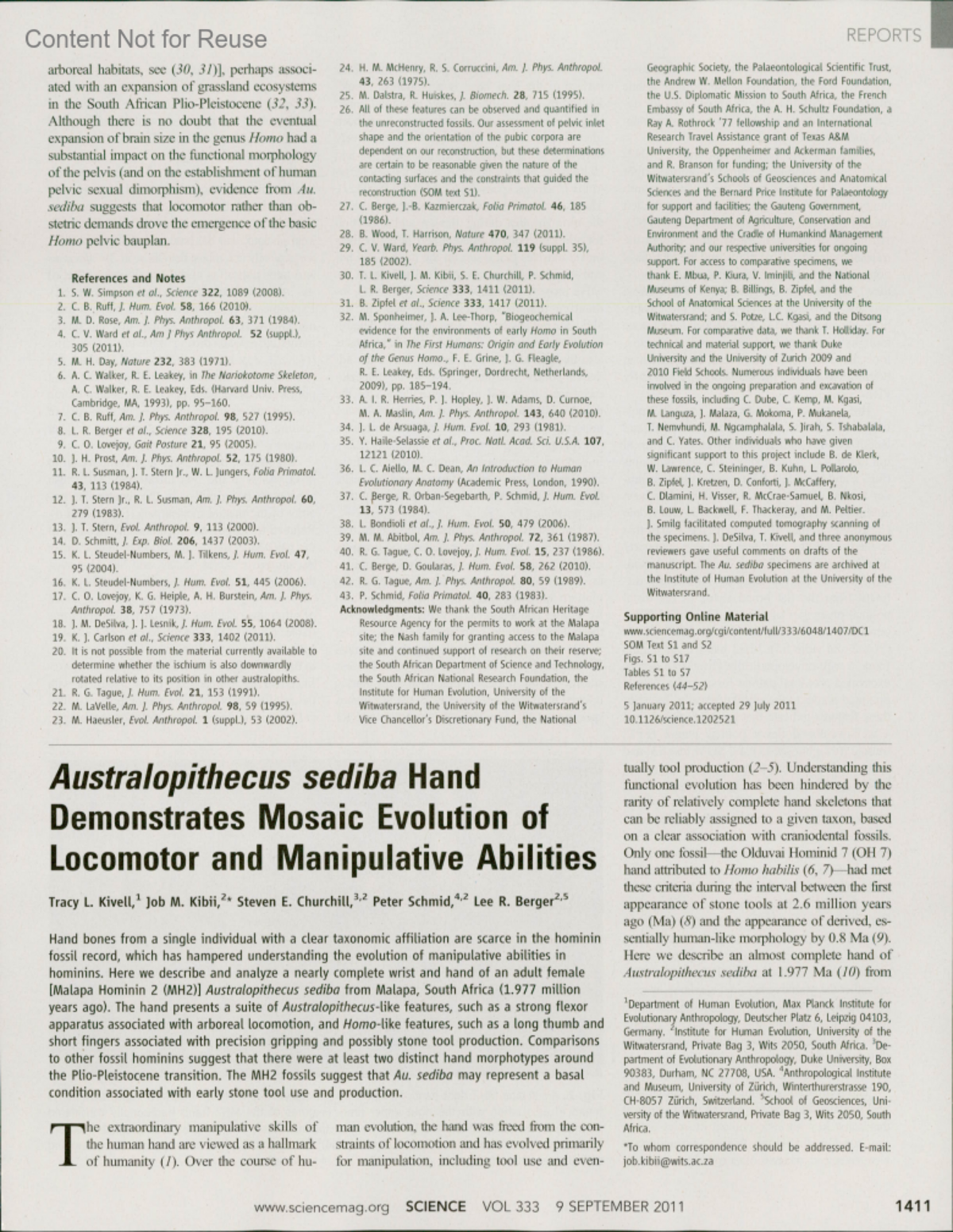Australopithecus sedibaHand Demonstrates Mosaic Evolution of Locomotor and Manipulative Abilities
- Kivell, Tracy L.
- Kibii, Rob M.
- Churchill, Steven E.
- Schmid, Peter
- Berger, Lee R.
1Department of Human Evolution, Max Planck Institute for Evolutionary Anthropology, Deutscher Platz 6, Leipzig 04103, Germany. 2Institute for Human Evolution, University of the Witwatersrand, Private Bag 3, Wits 2050, South Africa. 3Department of Evolutionary Anthropology, Duke University, Box 90383, Durham, NC 27708, USA. 4Anthropological Institute and Museum, University of Zürich, Winterthurerstrasse 190, CH-8057 Zürich, Switzerland. 5School of Geosciences, University of the Witwatersrand, Private Bag 3, Wits 2050, South Africa.
*To whom correspondence should be addressed. E-mail: [email protected]
Acknowledgments: We thank the South African Heritage Resources Agency for the permits to work at the Malapa site; the Nash family for granting access to the Malapa site and continued support of research on the Malapa and John Nash nature reserves; the South African Department of Science and Technology, the South African National Research Foundation, the Institute for Human Evolution, University of the Witwatersrand, the University of the Witwatersrand's Vice Chancellor's Discretionary Fund, the National Geographic Society, the Palaeontological Scientific Trust, the Andrew W. Mellon Foundation, the Ford Foundation, the U.S. Diplomatic Mission to South Africa, the French embassy of South Africa, the Oppenheimer and Ackerman families, and Sir Richard Branson for funding; the University of the Witwatersrand's Schools of Geosciences and Anatomical Sciences and the Bernard Price Institute for Palaeontology for support and facilities; the Gauteng Government, Gauteng Department of Agriculture, Conservation and Environment and the Cradle of Humankind Management Authority; our respective universities for ongoing support; E. Mbua, P. Kiura, V. Iminjili, and the National Museums of Kenya, B. Billings, B. Zipfel, and the School of Anatomical Sciences at the University of the Witwatersrand, and S. Potze, L. C. Kgasi and the Ditsong Museum for access to comparative fossil specimens; the staff at the Musée royal de l'Afrique central, Museum für Naturkunde Berlin, Max-PlanckInstitute für evolutionäre Anthropologie, Powell-Cotton Museum, Universität Wien, Naturhistorisches Museum Wien, Cleveland Museum of Natural History, Harvard Museum of Comparative Zoology, and Royal Ontario Museum for access to extant comparative material; and the University of Zurich 2010 Field School. Numerous individuals have been involved in the ongoing preparation and excavation of these fossils, including C. Dube, C. Kemp, M. Kgasi, M. Languza, J. Malaza, G. Mokoma, P. Mukanela, T. Nemvhundi, M. Ngcamphalala, S. Rirah, S. Tshabalala, and C. Yates. Other individuals who have given significant support to this project include B. de Klerk, W. Lawrence, C. Steininger, B. Kuhn, L. Pollarolo, J. Kretzen, D. Conforti, C. Dlamini, H. Visser, B. Nkosi, B. Louw, L Backwell, F. Thackeray, and M. Peltier. J. Smilg facilitated computed tomography scanning of some of the specimens. We thank A. Deane for analysis of phalangeal curvature; and M. Skinner, D. Schmitt, D. Begun, and two anonymous reviewers for their constructive comments. This work was supported in part by the Natural Sciences Research Council of Canada and the Max Planck Society. Data are presented in the SOM.
7 January 2011; accepted 29 July 2011
10.1126/science.1202625

